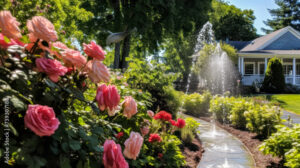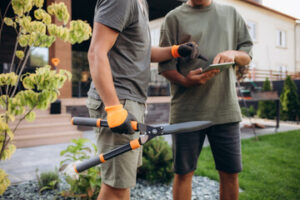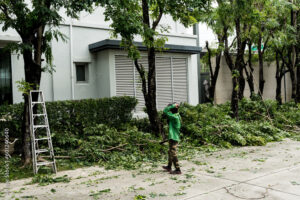
Trees and shrubs are the backbone of our landscapes, offering shade, beauty, and a touch of nature’s elegance. But beyond their aesthetic appeal, these green giants play a crucial role in ecological balance, air quality, and even the property value of our homes. Yet, many homeowners are unaware of the simple steps they can take to ensure the health and longevity of these silent guardians. In this definitive guide, we’ll explore DIY tree and shrub care, focusing on inspection, pruning, and techniques to manage the greenery in your outdoor oasis effectively.
Understanding the Importance of Inspection
Inspection is the first line of defense in tree and shrub maintenance. It allows you to spot issues early, which can make a significant difference in their health and growth. By committing to a regular inspection routine, you’ll become familiar with the state of your plants, and be in a much better position to address any problems that might arise. Here’s how to conduct a thorough inspection:
When to Inspect
Timing is key in effective tree and shrub care. Inspections should be carried out at least twice a year, ideally at the end of winter and halfway through the growing season. This schedule ensures that you spot winter damage and keep an eye on the plant’s development.
 What to Look For
What to Look For
- Dead or Dying Branches: Look for branches that have no leaves or are visibly decaying. These can be a sign of disease or pest infestation and should be pruned to prevent further spread.
- Cracks and Wounds: Trees can be wounded by storms, improper pruning, or even by lawnmowers. These openings can invite pests and diseases. Monitoring them is crucial.
- Changes in Foliage: The presence of spots, discoloration, or stunted growth can indicate a problem. Take note of what’s out of the ordinary and investigate further.
- Root Zone: Soil compaction, root girdling, and surface roots strangling each other can be significant issues. Gently probe the soil to ensure their health.
Follow and subscribe to our YouTube channel for tons of Great information.
Website constructionconsumeradvocacyinstitute.com
Podcast anchor.fm/galloway
www.youtube.com/@ConstructionConsumerAdvocacy
 The Art of Proper Pruning
The Art of Proper Pruning
Pruning is the most common tree and shrub maintenance task, and when done correctly, it can promote healthier growth, improve the plant’s structure, and even prevent some safety hazards. However, improper pruning can lead to a myriad of problems. Here are the key things to consider:
What to Prune
- Deadwood: Always remove dead or diseased branches.
- Crossovers and Rubbing Branches: This prevents damage and allows for balanced growth.
- Water Sprouts and Suckers: These rapid-growing branches detract from the overall health and aesthetics of the plant.
- Branches That Obstruct Traffic or Structures: Raise canopies or reduce length to prevent accidents or damage to property.
Techniques to Use
To ensure you’re employing proper pruning techniques, follow these pointers:
- Use the Right Tools: Hand pruners, loppers, pruning saws, and pole pruners are the main tools used for pruning. Ensure they’re sharp and sanitized to prevent the spread of diseases.
- The Three-Cut Method: When dealing with larger branches, use the three-cut method to prevent bark stripping and damaging the branch collar.
- Maintain the Natural Shape: Don’t over-prune. Maintain the natural shape of the tree or shrub as best you can to ensure proper growth.
  Safety Considerations
 Safety Considerations
- Work with Gravity: When pruning, consider how the branch will fall or be lowered. Always work with gravity to prevent injury.
- Wear Safety Gear: Protective eyewear, gloves, and head protection should be worn whenever pruning or cutting branches.
- Know Your Limits: If a tree or shrub is too large or near utility lines, it’s best to call in a professional arborist.
Additional Seasonal Care Tips
Beyond inspections, pruning, and growth management, there are additional seasonal steps you can take to ensure the health of your trees and shrubs:
Spring
- Fertilization: Consider feeding your trees and shrubs in the spring to kickstart the growing season.
- Mulching: Mulch can help retain moisture and protect roots. Use a layer that’s 2-4 inches thick but keep it several inches from the tree trunk.
- Watering: Pay attention to rainfall levels, and water as needed to keep the soil consistently moist, but not waterlogged.
- Conclusion
- Caring for the trees and shrubs in your yard can be incredibly rewarding. By committing to a routine of inspection and maintenance, you’re not only enhancing the beauty of your home but also promoting a healthy environment for plant and animal life. Remember, it’s crucial to know your limits. If a task seems too daunting or requires climbing, it’s best to call in a professional. With the tips and techniques provided in this guide, you’re well on your way to becoming a steward of the greenery in your own backyard, ensuring a legacy that will thrive for generations to come.
Follow and subscribe to our YouTube channel for tons of Great information.
Website constructionconsumeradvocacyinstitute.com
Podcast anchor.fm/galloway
www.youtube.com/@ConstructionConsumerAdvocacy
